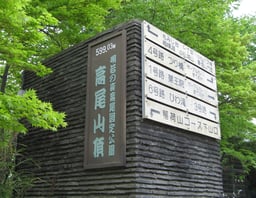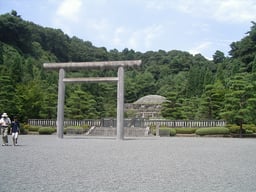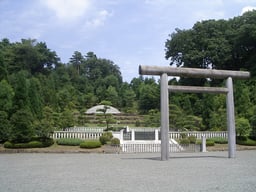Hachiōji, Tokyo
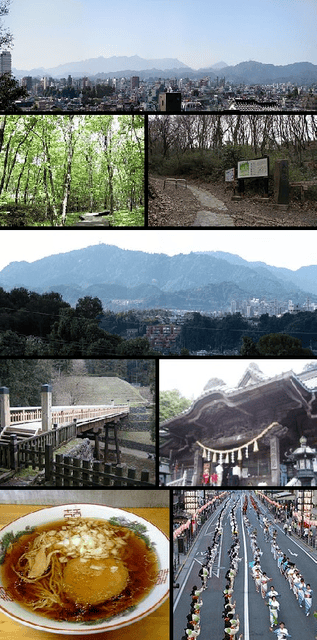
Hachiōji, Tokyo

Hachiōji 八王子市 | |
|---|---|
Core city | |
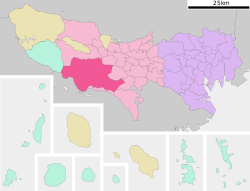 Location of Hachiōji in Tokyo | |
| Coordinates:35°39′59.2″N 139°18′57.6″E [5] | |
| Country | Japan |
| Region | Kantō |
| Prefecture | Tokyo |
| Government | |
| • Mayor | Takayuki Ishimori(石森 孝志,Takayuki Ishimori) |
| Area | |
| • Total | 186.38 km2(71.96 sq mi) |
| Population (February 2016) | |
| • Total | 579,330 |
| • Density | 3,110/km2(8,100/sq mi) |
| Time zone | UTC+9 (Japan Standard Time) |
| Symbols | |
| • Tree | Ginkgo biloba |
| • Flower | Lilium auratum |
| • Bird | Blue-and-white flycatcher |
| Phone number | 042-626-3111 |
| Address | 3-24-1 Motohongo-cho, Hachiōji-shi, Tokyo 192-8501 |
| Website | www.city.hachioji.tokyo.jp [6] |
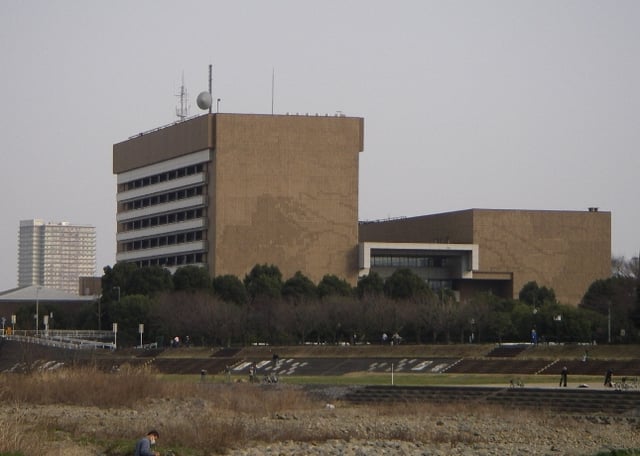
Hachiōji City Hall
Hachiōji (八王子市, Hachiōji-shi) is a city located in the western portion of Tokyo Metropolis, Japan. As of 1 February 2016, the city had an estimated population of 579,330, and a population density of 3110 persons per km2. Its total area is 186.38 square kilometres (71.96 sq mi).
Hachiōji 八王子市 | |
|---|---|
Core city | |
 Location of Hachiōji in Tokyo | |
| Coordinates:35°39′59.2″N 139°18′57.6″E [5] | |
| Country | Japan |
| Region | Kantō |
| Prefecture | Tokyo |
| Government | |
| • Mayor | Takayuki Ishimori(石森 孝志,Takayuki Ishimori) |
| Area | |
| • Total | 186.38 km2(71.96 sq mi) |
| Population (February 2016) | |
| • Total | 579,330 |
| • Density | 3,110/km2(8,100/sq mi) |
| Time zone | UTC+9 (Japan Standard Time) |
| Symbols | |
| • Tree | Ginkgo biloba |
| • Flower | Lilium auratum |
| • Bird | Blue-and-white flycatcher |
| Phone number | 042-626-3111 |
| Address | 3-24-1 Motohongo-cho, Hachiōji-shi, Tokyo 192-8501 |
| Website | www.city.hachioji.tokyo.jp [6] |
History
The area of present-day Hachiōji was part of ancient Musashi Province. It has been an important junction point and post town along the Kōshū Kaidō, the main road that connected the historical Edo (today's Tokyo) with western Japan. Hachiōji Castle was built during the Sengoku period in 1584 by Hōjō Ujiteru, but was soon destroyed in 1590 by Toyotomi Hideyoshi. During the Edo period, the area was tenryō controlled directly by the Tokugawa shogunate.
In the post-Meiji Restoration cadastral reform of July 22, 1878, the area became part of Minamitama District in Kanagawa Prefecture. The town of Hachiōji was created on April 1, 1889, with the establishment of municipalities law. Minaitama District was transferred to the administrative control of Tokyo Metropolis on April 1, 1893. Hachiōji gained city status on September 1, 1917.
During the 1964 Summer Olympics, the city played host to the road cycling events. A velodrome in the city played host to the track cycling events.[1]
Geography
Hachiōji is located in the foothills of the Okutama Mountains of western Tokyo, about 40 kilometers west of the center of the 23 special wards of Tokyo. The city is surrounded on three sides by mountains, forming the Hachioji Basin which opens up toward the east in the direction of Tokyo. The mountain ranges in the southwest include Mount Takao (599 m) and Mount Jinba (857 m), two popular hiking destinations which can be reached by train and bus, respectively.
Surrounding municipalities
Tokyo Metropolis Machida Tama Fussa Hino Akishima Akiruno Hinohara
Kanagawa Prefecture Sagamihara
Climate
Mayors of Hachiōji (1917–present)
Economy
During the Meiji period, Hachiōji prospered as an important location for the production of silk and silk textiles. The industry faded away, however, in the 1960s. Today, Hachiōji mainly serves as a commuter town for people working in Tokyo, and as a location for many large colleges and universities.
Education
Colleges and universities
Chuo University (Tama Campus)
Digital Hollywood University
Kogakuin University (Hachioji Campus)
Kyorin University (Hachioji Campus)
Meisei University (Hino Campus)
Nihon Bunka University
Soka University
Tama Art University (Hachioji Campus)
Takushoku University (Hachioji Campus)
Teikyo University (Hachioji Campus)
Tokyo Junshin University
Tokyo Kasei-Gakuin University (Machida Campus)
Tokyo Metropolitan University (Minamiōsawa Campus)
Tokyo University of Agriculture and Technology
Tokyo University of Pharmacy and Life Sciences
Tokyo University of Technology (Hachiōji Campus)
Tokyo Zokei University of Art and Design
Nippon Engineering College
Primary and secondary education
Hachiōji has 70 public elementary schools and 37 public middle schools operated by the city government, as well as four public combined elementary/middle schools. The Tokyo Metropolitan Government Board of Education operates nine public high schools, and there are also eleven private high schools.
The metropolis also operates the Hachioji School for the Blind.
Transportation
Railways
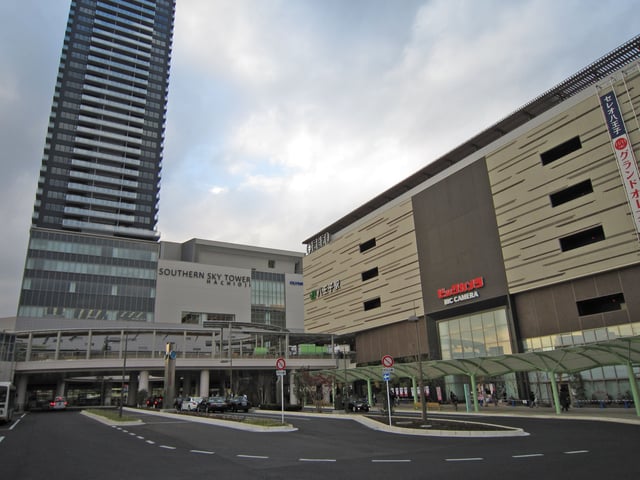
Hachiōji Station
JR East- Chūō Main Line Hachiōji - Nishi-Hachiōji - Takao
JR East- Yokohama Line Hachiōji-Minamino - Katakura - Hachiōji
JR East- Hachikō Line Hachiōji - Kita-Hachiōji - Komiya
Keio Corporation - Keiō Line Naganuma - Kitano - Keiō-Hachiōji
Keio Corporation - Keiō Takao Line Kitano - Keiō-Katakura - Yamada - Mejirodai - Hazama - Takao - Takaosanguchi
Keio Corporation - Sagamihara Line Keiō-Horinouchi - Minami-Ōsawa
Tama Toshi Monorail Line Chūō-Daigaku-Meisei-Daigaku - Ōtsuka-Teikyō-Daigaku - Matsugaya
Takaotozan Railway
Highways
Chūō Expressway
Ken-Ō Expressway
Japan National Route 16
Japan National Route 20
Japan National Route 411
Sister city relations
Local attractions
Hachioji stretches over a large area, combining such diverse parts as the densely populated city center and its shopping district with the hardly populated rural areas in the west.
Mt. Takao (599 m) is a popular hiking destination in the southwest, easily accessible through the Keiō Takao Line. It is famous for the Shingon Buddhist temple Takao-san Yakuōin Yūkiji (高尾山薬王院有喜寺).
Mt. Jinba (855 m) is more difficult to reach, requiring a one-hour bus ride from the city center. It is popular, however, because of the scenic view toward Mt. Fuji.
Tama Forest Science Garden
Tokyo Fuji Art Museum
Musashi Imperial Graveyard houses the remains of the Taishō and Shōwa emperors.
Takiyama Castle
Hachiōji Castle


